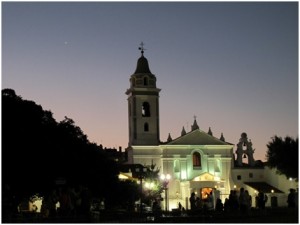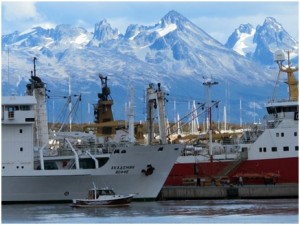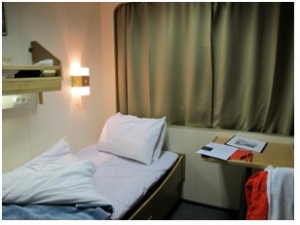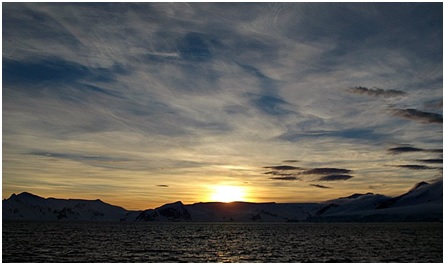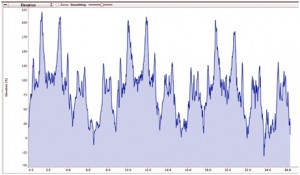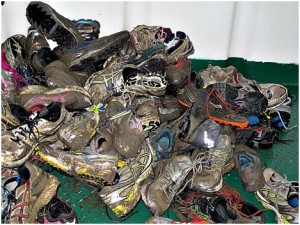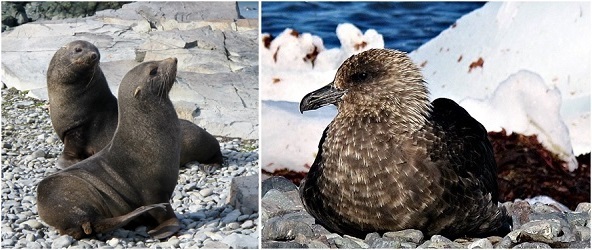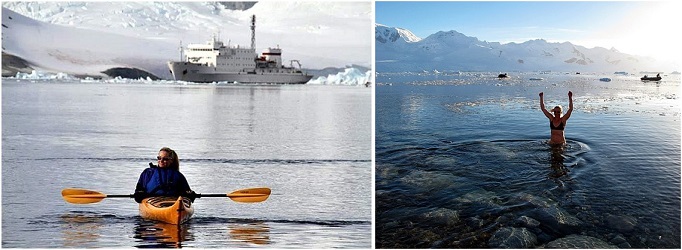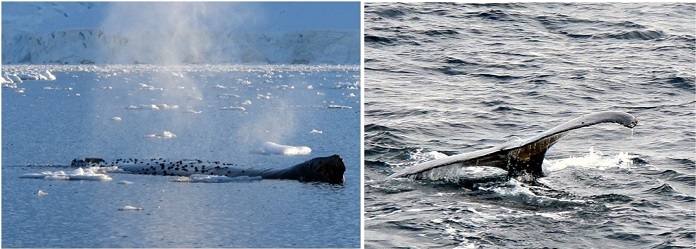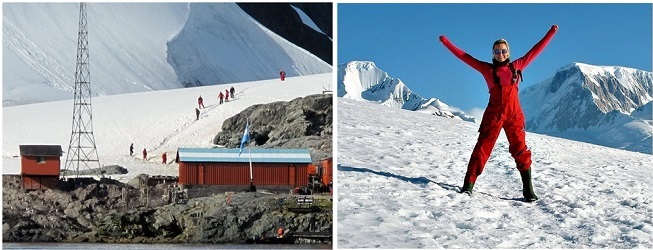Antarctica Marathon 2012
Back to Brooke’s Marathon Miles page
The adventure begins Thursday, March 1, 2012. My fellow runners and I fly to Buenos Aires from points around the world, and from at least 15 different countries, to meet our fearless leaders from Marathon Tours. We fly through the night and I feel lucky to have a nonstop from Dulles to BA and arrive relatively rested.
For logistical reasons, we spend a few days in BA; it’s the capital and the largest city in Argentina, and birthplace of Avita. I recognize a few runners from other marathons, namely Eileen and Cyrus from the Sticky Rice bus in China. It’s 85 degrees and shockingly hot coming from DC’s 40 degree weather. We have time to get to know one another and investigate the local scene: group runs, city walkabouts, street markets, and nightlife. A bus tour shows us the highlights: embassies, Japanese gardens, La Boca. We make special stops at La Ricoletta — 14 acre cemetery on the outskirts of town containing 4,691 vaults, many notable: Eva Peron and several Argentinian presidents — and the Main Square: cathedral, national bank, government buildings and where the Walk for the Missing occurs every Thursday.
The next leg of our trip begins early on Monday, March 4 with a three hour flight from BA to Ushuaia. Ushuaia — also in Argentina — is located in Tierra del Fuego and is the southernmost city in the world. It’s the gateway to the Antarctic and where we meet our ship the Akademik Ioffe! It is a Russian Research vessel which travels between the Arctic and the Antarctic, with commissioned trips in the off season. It is no cruise ship, but is strong and comfortable, with a reinforced steel hull that can handle any iceberg mishaps. I think a lot about the icebergs, especially at night. Late that afternoon, we board and have a mandatory evacuation drill. Three loud blasts sound and we set sail… through the Beagle Channel and towards the infamous Drake Passage!
I take every precaution against motion sickness even though it makes me ‘loopy’ and incredibly thirsty. The Drake Passage is notorious for its unpredictable and brutally-violent storms created by the worlds’ ocean waters squeezing through the narrow passage between Cape Horn and Antarctica. Lucky for us, we get the ‘Drake Lake’ and experience little more than minor inconveniences. Some of us feel slighted — maybe me? — and wish for about 30 minutes of hull-thumping excitement.
*Factoid #1: It takes 120 years for all the oceans’ waters to cycle through the Drake Passage.
Tuesday and Wednesday, March 5 and 6, it is full steam ahead though Drake Passage and towards our first stop, King George Island, Antarctica.
Once at sea, Thom Gilligan — can you believe we set sail with a guy named Gilligan?! — of Marathon Tours hands over the reins to Andrew of OneOcean Expeditions and the 40 or so Russian sailors and crew whose job it is to get us to Antarctica. I’ll never forget Andrew’s PA announcements (and more announcements and if there was a whale, announcements every few minutes). Soothingly-smooth and something like this:
“Good morning ladies and gentlemen. Good morning. It is 6:30 in the morning and currently 4 degrees outside. We’ve been traveling through the Gerlache Strait at 11 knots. There is a beautiful sunrise coming up off the starboard side for those of you out and about. Breakfast will be served at 7:30. Hope to see you there.”
Thank you Andrew for your calm leadership on the water!
These two days are spent waiting for the main event. Even though we are on our way, there is no guarantee the weather will cooperate to run a marathon. I’m anxious but bide my time with mandatory briefings and interesting wildlife, geography and history lectures. We are sailing towards the things that we are learning about: penguins, sea bird, whales, sea lions, orcas and icebergs, Amundsen, Scott and Shackleton. So cool! To keep us entertained — besides the ‘honor’ bar — we have a cutthroat contest:
• First Iceberg Spotting: be the closest by time and latitude. I’m not sure what happened to the winner — no, no… just kidding!
*Factoid #2: Due to water freezing, Antarctica doubles in size during the winter.
*Factoid #3: Glaciers are formed from compacted snow, Icebergs from glacier break-off or freezing sea water.
Thursday, March 7 King George Island (site of the marathon) Marathon Tours spends the day offloading ATV’s and supplies into zodiacs and setting up for the marathon we are told will happen the next day! Relief and heightened anticipation. We have a morning lecture and then our first excursion to Robert Point; a sandy and rocky beach that leads to dramatic, craggy rust-colored mountains. Tenacious lichen and moss grab hold of the surfaces. We see our first animals: Chinstrap and Adelie penguins — there are 10,000 pairs of them! — Elephant Seals, Giant Petrels, Terns and Skuas (dive-bombing birds — humans are known targets). We’ll later see Humpback Whales, Killer Whales (Orcas), Leopard Seals and more. We are up-close and personal with the animals. Sometimes a little too close…penguin poo smells.
*Don’t miss this amazing Wildlife List!
Friday, March 8 Race Day! Rain and wind are in the forecast with an expected high temperature of 35 degrees. We breakfast and board the zodiacs in shifts starting about 7:30 for the 10 minute trip ashore. All of us wear multiple layers of clothing, topped off with our water and wind-proof red suits. As we go through the mudroom, we don rubber boots and PFD’s. This is the drill whenever we prepare to leave the ship: red suits, knee-high rubber boots, life vests, and then a quick exit to the gangplank. On return, it’s the same but in reverse. We use the ‘firefighters grip’ when boarding or disembarking the zodiacs; safety rules as a misstep has potential for some pretty serious consequences.
We carry a backpack ashore with our running shoes, hydration, nourishment and anything extra we think we may need. This is no usual marathon! There are no smiling volunteers, no aid-stations, no water stops; we are totally self-reliant. There is strict protocol with which we have to adhere: whatever we bring to the island, we have to take off the island. This includes ‘Facility’ contents that are collected in a heavy-duty trash bags. Food products — excluding those with nuts and eggs — are allowed but have to be taken out of their packaging and placed in reusable containers. I empty 5 gel packets into a squeezable mini-bottle; we fill reusable water bottles for our hydration. Any violation of these rules results in immediate disqualification.
It begins to rain as we change out of our ‘zodiac duds’ and into our running gear. I wear gortex trail shoes — thanks Dr. Furman and podiatry friends for the spot-on shoe/sock recommendations — with gaiters, heavy running tights and a thick compression top. My outer shell is a most-excellent light-weight wind and waterproof jacket. Thankfully, my hands are warm too. I’ve experimented with a pair of gloves under a pair of mittens; 6-hour hand-warmers tucked inside the mitten tips make me most happy. We stuff our bags under a trailor-ed boat and line up behind the banner. Our spirits are high as we are realizing a dream.
One-hundred-and-six brave and hearty souls toe up behind the banner and the race starts! One Australian runs in a chicken suit for charity; I vividly remember the bright yellow of his suit contrasting with the prevailing brown color of the mud as he proceeds up that first hill. It occurs to me that we all might be a little crazy. There is another runner raising funds forpenguin conservation and a third who is attempting to break a Guinness World Record by running a marathon on each the continents in the fewest amount of days; Antarctica is the beginning of his journey. He succeeds!
We start out together but the group quickly thins. I purposefully stay mid-pack and run by effort. I feel like I’m working pretty hard and don’t want to go out too fast. By mile 2, after I taste the relentless hills, the unsure footing, the wide streams we have to transverse, I downgrade my expectations and dig in. Conserving energy becomes my goal; I decide to walk the steepest of the hills.
The marathon is a triple out-and-back with the Start/Finish in the middle of the course at the Russian Base. From the start, it is 2.18 miles out to the Uruguayan Base, where we turn around and run along the same path back to the Start/Finish line. We continue through the Start/Finish line and run another 2.18 miles to the Chinese Base, and then turn around and run back to the beginning. We do this three times. The twenty-nine half-marathoners will follow the same course but do three legs instead six.
As the marathon progresses, the course conditions deteriorate. The mud gets deeper, the streams wider, the round ostrich egg-shaped stones get more exposed and slipperier, the wind whips up to a sustained 40 mph. We have sideways snow, but we soldier on, encouraging each other as we pass. I look forward to seeing the Marathon Tours and OneOcean staff and hearing their shouts of encouragement. I can only imagine how cold they are.
As the miles wear on, I wonder if I have played it too conservatively. I feel good and I have hopes to do well. But by mile 16, I haven’t caught up to the female frontrunners and they look strong. I watch and I wait and I bide my time. By mile 18, there is hope, and I overtake a powerful runner from New Zealand. Around mile 22, I get lucky and push ahead the final runner, a tough competitor from Washington state. Looking over my shoulder the whole time, I ran it home.
Seventy-eight of us finish the marathon that day. A few runners make a smart choice and downgrade to the half-marathon. Thinking back, I am still warmed by the standing ovation my fellow runners gave me at the bar that evening. Well done everyone, well done!
*Factoid #4: Extra days ‘pad’ race day in case of weather so severe that the zodiacs can’t reach land safely. This was the case in 2001. After five days of waiting for the weather to clear, they decided to hold the race on the ship; four separate waves and on two different decks, taking advantage of the perpetual summer light.
Saturday, March 10 – Monday, March 12
Now that the marathon is run, it is time to relax and settle into a vacation-like schedule and enjoy the best of Antarctica. Our mornings and afternoons are spent in the zodiacs taking excursions. It is hard to describe the scenery without using hyperbole, so I won’t try. The panoramas are too extensive, the glaciers too vast and the wildlife so incredible and so ubiquitous that it almost becomes ho-hum; should I really go out on deck to see another whale? I mean I practically touched one already today… We sail into a region of broad straits and mountainous islands that dramatically burst out of the water: Trinity and Cuverville Island. The ship navigates through protected bays and narrow channels, with icebergs that tower and seem close enough to touch. We go in and out of Mikkelsen Harbor, the Gerlache Straight, Neko Harbor and Paradise Bay. I know we see summits that have never been climbed and sights never been seen! Better yet? It is just us, no other boats, no other people, no other sounds, just us and all this wide open space. I will let the photos below tell more of the story because my words fail me.
We all go to Antarctica for the marathon but ironically, it ends up being a minor portion of the overall trip. Kudos Marathon Tours for your fine leadership and organization of this most amazing race — this truly was an experience of a lifetime!
We turn north and set course for Cape Horn about 6 PM Monday evening. It is another perfect day in Antarctica but I’m ready; this is where I film the ‘Goodbye Antarctica’ video in the right sidebar. We enter the Drake Passage and have another smooth sail over Tuesday, March 12 and through Wednesday, March 13. It is anticlimactic and I am antsy to get off the ship. Late Wednesday afternoon we come around Cape Horn and head back into Beagle Channel for Ushuaia. We disembark in the morning of Thursday, March 14 and then head to the airport where we all fly to Buenos Aires and then splinter to cities around the world. I remember Bill of Marathon Tours telling me that it takes awhile to get over a trip like this. He is right.
Be well my friends! Brooke
Back to Brooke’s Marathon Miles page
*Brooke pays for all of her own travel costs and related fees. She runs (24,000 miles and counting…) with asthma and exercise-induced asthma.



